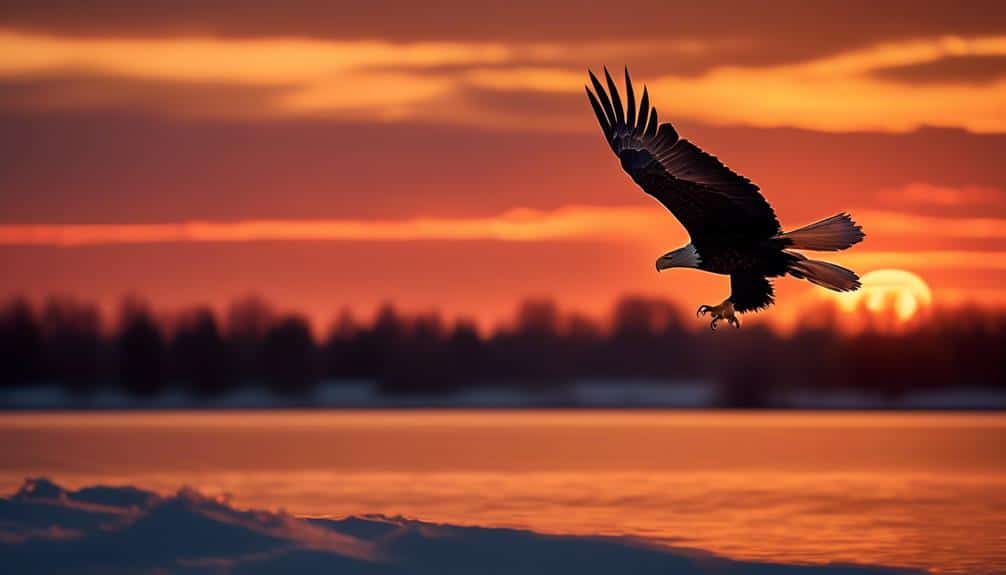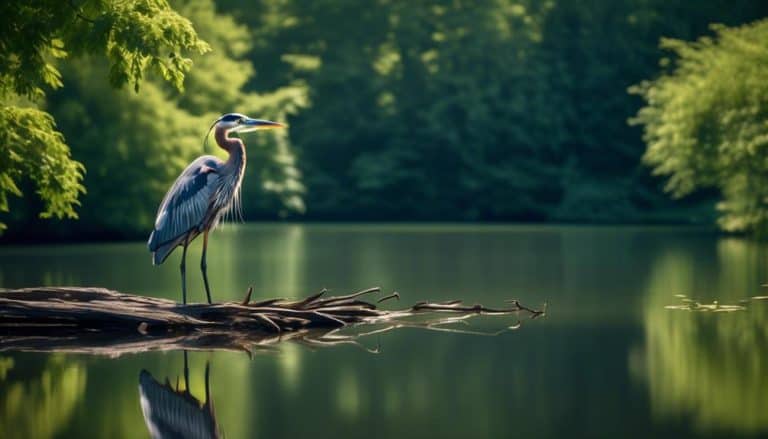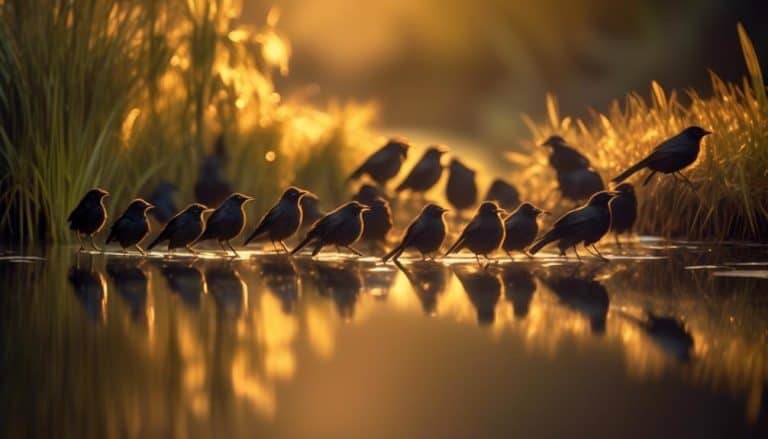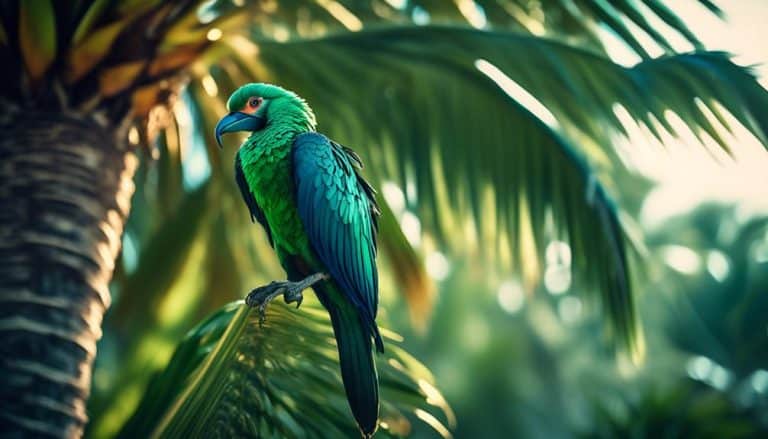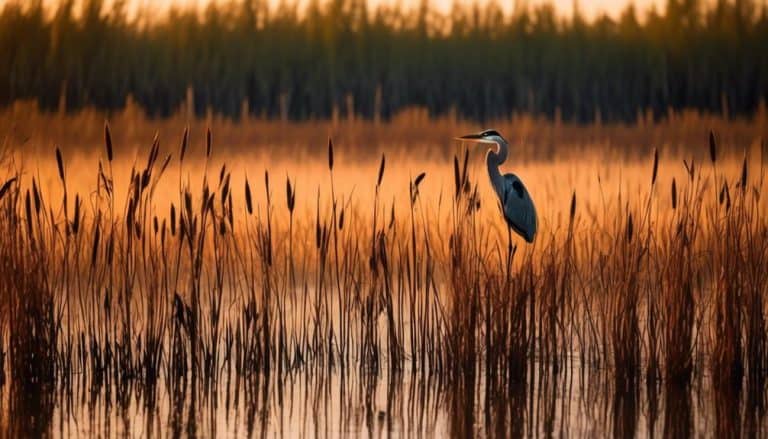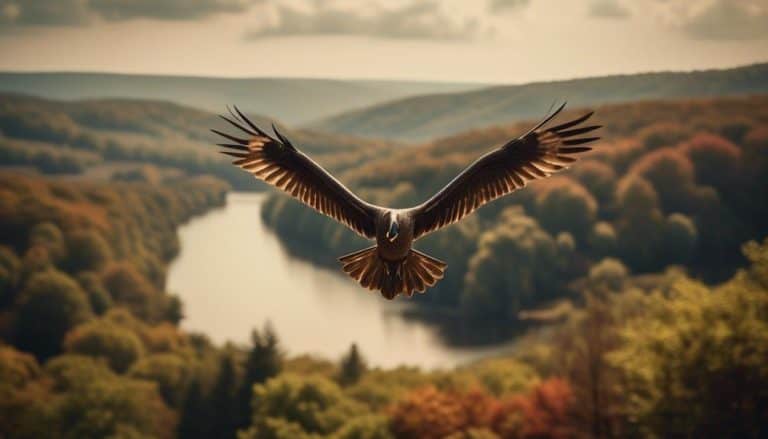As a birder in Wisconsin, I know that large birds might not be the first thing that comes to mind when you think of our state.
However, you might be surprised to learn that Wisconsin is home to various impressive avian species. From the majestic bald eagles soaring through our skies to the elegant great blue herons silently stalking our waters, these large birds add a touch of grandeur to our natural landscapes.
But that’s not all. Other magnificent creatures are waiting to be discovered, and I can’t wait to share their stories with you.
Bald Eagles: The Aerial Kings of Wisconsin
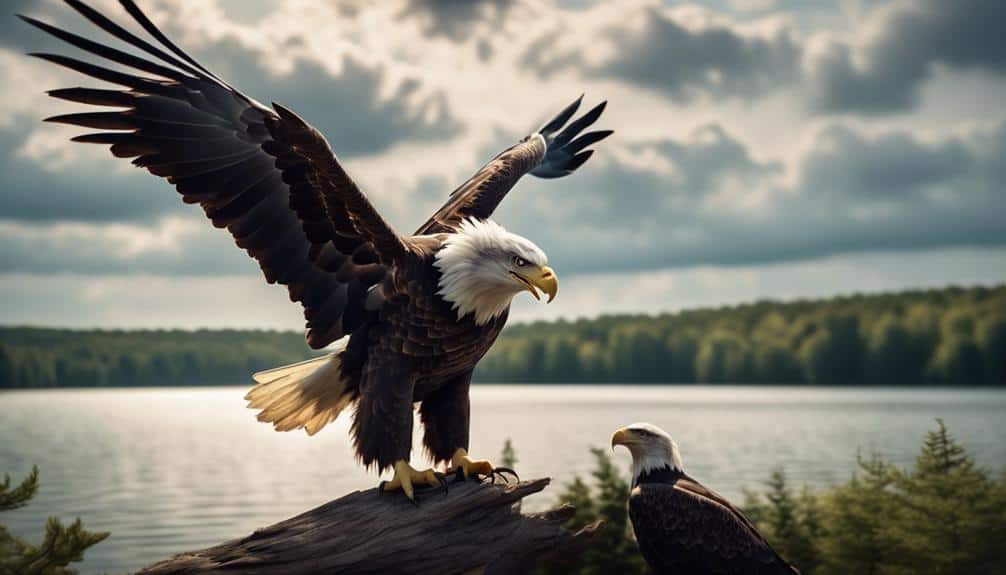
As an avid bird watcher in Wisconsin, I’m constantly in awe of the majestic sight of Bald Eagles soaring through the sky, their powerful wingspan and keen eyesight making them the undisputed aerial kings of our state. The conservation efforts in Wisconsin have played a crucial role in recovering the bald eagle population. Thanks to these efforts, the number of nesting pairs has significantly increased.
Bald eagles typically construct their nests in large, sturdy trees near bodies of water such as rivers and lakes. These nests, known as eyries, are massive structures of sticks, twigs, and vegetation lined with softer materials like moss and feathers. The eyries are often reused by the same pair of eagles year after year, with the nest growing in size as more materials are added.
The nesting habits of bald eagles are a fascinating subject of study. Breeding season usually begins in late winter or early spring, with the pair engaging in an elaborate courtship display. They perform aerial acrobatics, diving, and locking talons mid-air, reaffirming their bond. Once the pair has mated, the female lays one to three eggs, which are incubated for about 35 days. Both parents take turns incubating the eggs and caring for the hatchlings.
Sandhill Cranes: Graceful Giants of the Marshes
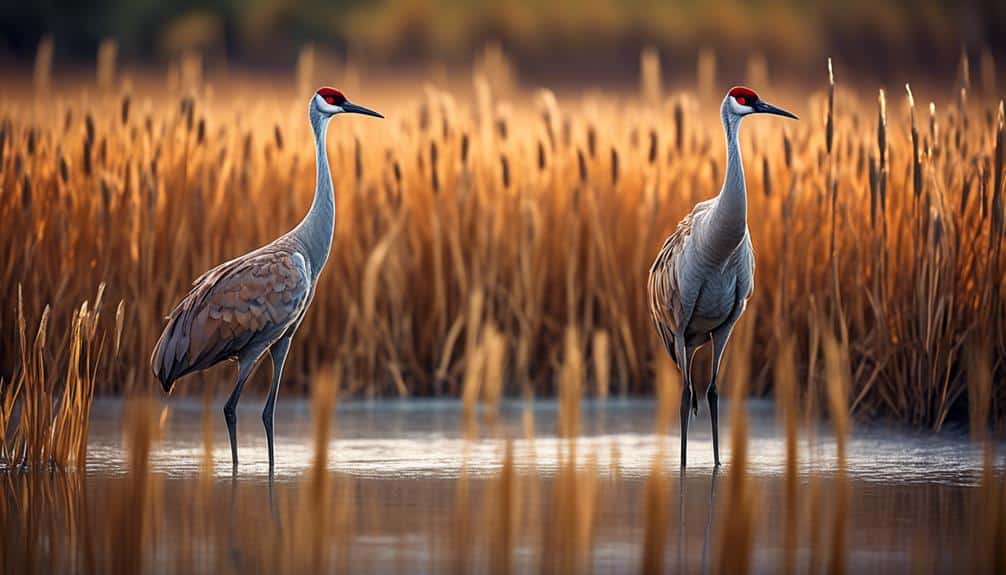
Sandhill Cranes, with their towering stature and graceful movements, dominate the marshes of Wisconsin. Standing at an impressive height of up to 4.5 feet, these majestic birds captivate the eye with their elegant long necks and slender bodies. Their gray plumage blends seamlessly with the surrounding wetland environment, providing excellent camouflage.
Sandhill Cranes are known for their remarkable annual migration, where they travel great distances in search of suitable breeding grounds and food sources. Thousands of these graceful giants undertake a long journey every year, covering distances of up to 5,000 miles. They soar through the skies with their wings outstretched, showcasing their impressive wingspan of up to 7 feet.
Conservation efforts have played a vital role in protecting the sandhill crane population in Wisconsin. Dedicated organizations and wildlife agencies have been working tirelessly to preserve their marshland habitats, ensuring these majestic birds have a haven to thrive. Through initiatives such as habitat restoration and public education, the importance of sandhill crane conservation is emphasized, fostering a greater understanding and appreciation for these magnificent creatures.
To further appreciate the beauty of sandhill cranes, let’s explore some fascinating facts about them:
| Scientific Name | *Antigone canadensis* |
| Habitat | Wetlands, marshes, and grasslands |
| Nesting | Construct large nests made of vegetation |
| Diet | Omnivorous, feeding on plants, seeds, insects, and small vertebrates |
| Distinctive Feature | Unison calls and elaborate courtship dances |
The sandhill cranes’ graceful crane migration and the ongoing sandhill crane conservation efforts highlight the significance of these avian giants in Wisconsin’s ecosystem. Their presence in the marshes reminds us of the importance of preserving and protecting our natural habitats for future generations to enjoy.
Great Blue Herons: Elegant Stalkers of Wisconsin’s Waters
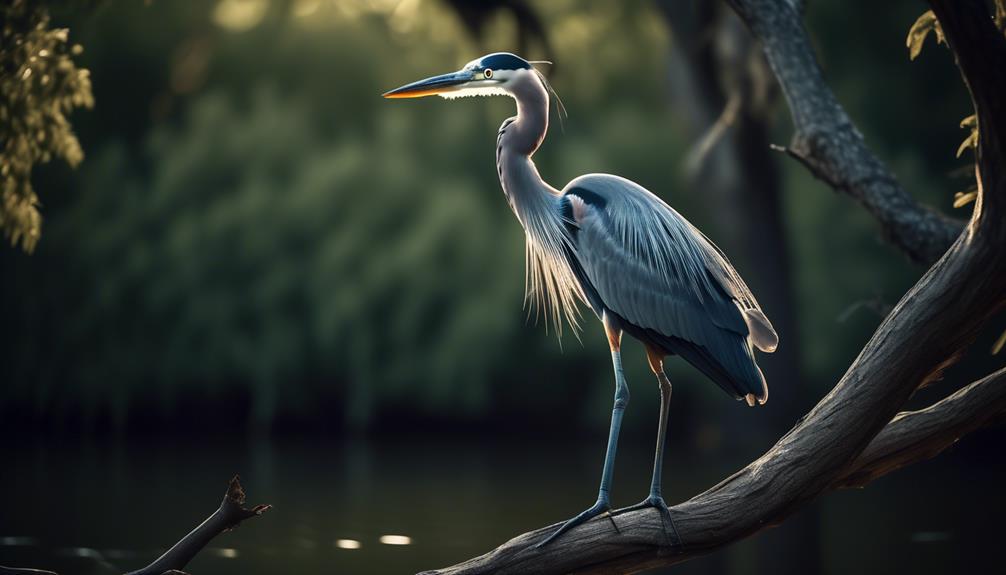
Great Blue Herons, with their long legs and sleek bodies, gracefully stalk the waters of Wisconsin, their keen eyes scanning for any movement beneath the surface. These elegant birds exhibit fascinating behavior and have adapted to various habitats across the state.
- Hunting Technique: Great Blue Herons are skilled hunters, patiently waiting motionless for their prey. Once a potential meal is spotted, they strike with lightning speed, using their sharp beak to snatch fish, amphibians, and even small mammals.
- Nesting Habits: These magnificent birds construct their nests high in the trees, often in colonies known as rookeries. The nests are made of sticks and lined with softer materials, providing a secure environment for their offspring. Great Blue Herons show great loyalty to their nests, returning to the same site year after year.
- Preferred Habitats: Great Blue Herons can be found in various wetland habitats, such as marshes, swamps, and lakeshores. They prefer areas with shallow waters, as it facilitates their hunting strategy. These areas also provide ample food sources for the herons, ensuring their survival.
Observing great blue heron behavior in their natural habitat is a captivating experience. Their precise movements, graceful flight, and stealthy hunting techniques make them remarkable creatures. Wisconsin’s waters are fortunate to be graced by the presence of these elegant stalkers.
Whooping Cranes: Endangered Beauties of the Midwest
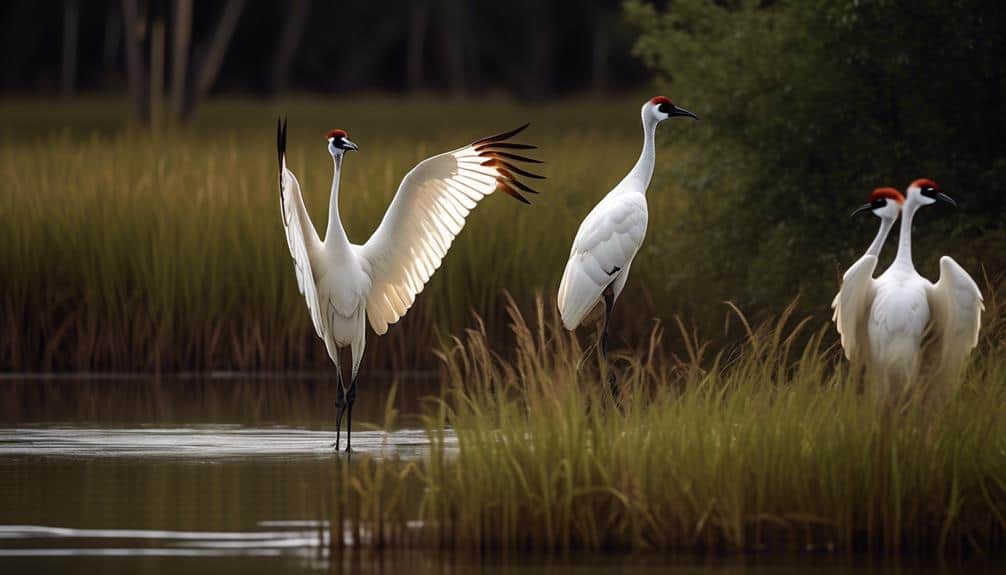
Whooping Cranes, with their striking white plumage and elegant stature, are a critically endangered species that captivate the hearts of those fortunate enough to witness their majestic presence in the Midwest. As one of the rarest birds in North America, they have become a symbol of conservation efforts and the importance of protecting our natural heritage.
These magnificent birds are known for their distinctive courtship dances, where they gracefully leap and bow, accompanied by resonating calls that can be heard from miles away. Their wingspan can reach up to 7 feet, making them the tallest birds in North America and a true spectacle.
Whooping Cranes have intricate migratory patterns across the United States and Canada. They breed in the wetlands of Wood Buffalo National Park in Canada and then journey through the Midwest to their wintering grounds along the Gulf Coast of Texas. This long-distance migration is a testament to their resilience and adaptability.
Sadly, the population of Whooping Cranes has plummeted due to habitat loss, hunting, and the use of pesticides. However, their numbers have slowly been recovering thanks to dedicated conservation efforts. Organizations like the International Crane Foundation and Operation Migration have been instrumental in reintroducing captive-bred Whooping Cranes into the wild and monitoring their progress.
We must continue to support these conservation initiatives to ensure the survival of this iconic species. By protecting their habitats and raising awareness about their plight, we can ensure that future generations can witness the beauty and grace of these endangered beauties in the Midwest.
| Whooping Cranes | |
|---|---|
| Plumage | Striking white |
| Stature | Elegant |
| Wingspan | Up to 7 feet |
| Breeding Grounds | Wood Buffalo National Park |
| Wintering Grounds | Gulf Coast of Texas |
| Threats | Habitat loss, hunting, pesticides |
| Conservation Efforts | International Crane Foundation, Operation Migration |
Wild Turkeys: Majestic Gobblers of the Wisconsin Woodlands
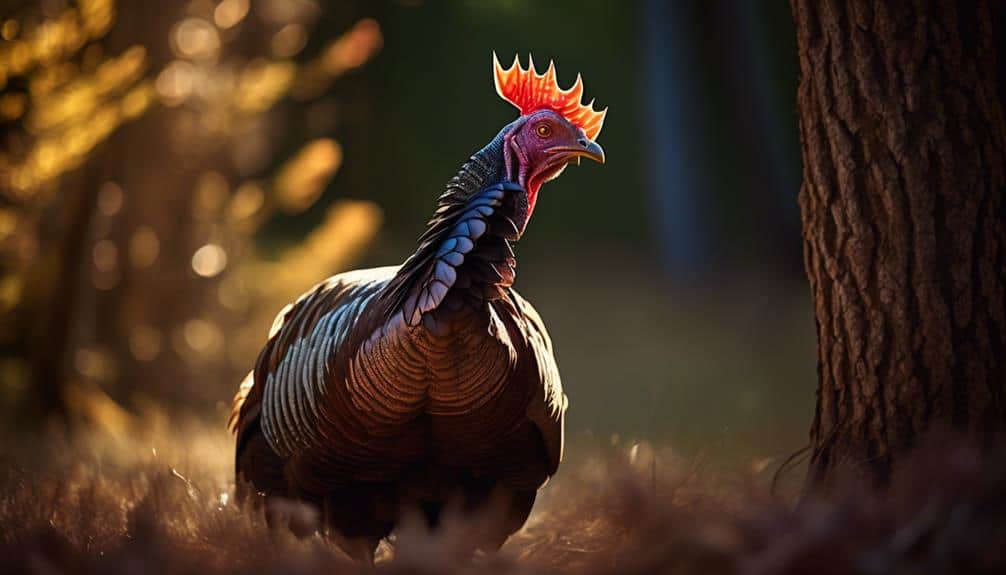
Wild Turkeys, with their vibrant feathers and impressive size, are prominent in the Wisconsin woodlands. These majestic gobblers symbolize the state’s wildlife diversity and are a popular sight for nature enthusiasts and hunters alike.
- Turkey hunting: Wisconsin has a strong turkey hunting tradition, attracting hunters from all over the country. The spring and fall turkey hunting seasons allow hunters to test their skills and enjoy the thrill of the chase. It’s important to note that hunting regulations are in place to ensure sustainable turkey populations and responsible hunting practices.
- Turkey population trends: Over the past few decades, the turkey population in Wisconsin has experienced significant growth. Thanks to successful conservation efforts and habitat restoration, the number of wild turkeys has increased steadily. This increase in population has allowed for the expansion of hunting opportunities while maintaining a healthy and sustainable turkey population.
- Behavior and habitat: Wild turkeys are known for their social behavior and can often be seen in groups called flocks. They prefer open woodlands with a mix of trees and grassy areas, providing them with food sources and suitable roosting sites. During the breeding season, male turkeys, or gobblers, display their vibrant feathers and perform elaborate courtship rituals to attract females.
Frequently Asked Questions
What Is the Average Lifespan of a Bald Eagle in Wisconsin?
The average lifespan of a bald eagle in Wisconsin is around 20-30 years. These majestic birds can be found throughout the state, along with other large birds like sandhill cranes, great blue herons, and whooping cranes. They exhibit fascinating nesting behavior and communicate through vocalizations. Bald eagles primarily feed on fish but consume various other prey, including waterfowl, small mammals, and carrion. They are a key species in the Wisconsin woodlands and contribute to the overall biodiversity of the Midwest.
How Do Sandhill Cranes Communicate With Each Other?
Sandhill cranes communicate with each other through a variety of vocalizations, including calls and loud bugling sounds. They use these vocalizations to establish territory, attract mates, and maintain social bonds within their flock.
What Is the Nesting Behavior of Great Blue Herons in Wisconsin?
During the breeding season, great blue herons in Wisconsin exhibit fascinating nesting habits. They construct intricate nests of sticks and engage in elaborate courtship rituals to attract mates. It is truly a sight to behold.
How Many Whooping Cranes Are Currently Living in the Midwest?
I’m not sure about the current number of whooping cranes in the Midwest, but I can tell you that their migration patterns are closely monitored as part of conservation efforts.
What Is the Diet of Wild Turkeys in the Wisconsin Woodlands?
In the Wisconsin woodlands, wild turkeys have a diverse diet. They forage for nuts, seeds, berries, insects, and even small reptiles. Their diet varies seasonally, with more plant-based foods in the summer and more insects in the spring.
Conclusion
In conclusion, the large birds of Wisconsin are truly magnificent creatures that captivate the senses. From the regal Bald Eagles soaring high above to the graceful Sandhill Cranes dancing in the marshes and the elegant Great Blue Herons stalking their prey, each bird possesses its unique beauty and charm.
As we marvel at their presence, we must also remember the endangered Whooping Cranes, a reminder of the delicate balance of nature.
Lastly, the majestic Wild Turkeys remind us of the wonders that await us in the Wisconsin woodlands.

